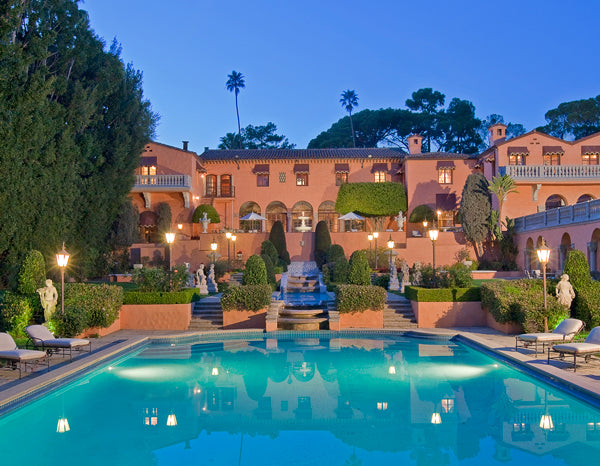North Beverly Drive – The Home of William Randolph Hearst and Marion Davies

The world of William Randolph Hearst and Marion Davies was one of extravagant mansions, dazzling parties, celebrity friends and hangers-on, and million-dollar shopping trips to Europe, all bound together by a genuine love. Their affair lasted thirty-four years, ending only with Hearst’s death in 1951.
In 1919, Hearst and Marion moved to California, where they lived openly together, a deliciously scandalous choice that provided decades of fodder for newspapers and magazines in competition with Hearst’s empire. The mansion at 1700 Lexington Road was the first in a series of lavish Beverly Hills homes. He already owns a luxurious lodge, Wyntoon, designed by architect Julia Morgan, in northern California, near the Oregon border. But all these homes were not enough for their life together.
Hearst wrote Morgan to discuss the 270,000 acres he owned in San Simeon, 250 miles north of Los Angeles, where he had often gone camping with family and friends. That “little something” would become a 165-room castle with outbuildings and 127 acres of grounds. Hearst filled the castle with architectural details; even whole ceilings and invaluable antiques including ancient Greek vases, rare oriental carpet, and tapestries. Among the thousands of works of art were sculptures and paintings by Albrecht Durer and William Hogarth.
Under the terms of Marion’s will, Captain Brown was given a trust fund that would provide a $3,000 monthly allowance, and he was allowed to live in the Beverly House for the rest of his life. Brown frequently rented the property as a film location and he sometimes played bit roles, but by the mid-1960s, he realized that he could not afford the estate’s upkeep.
The trustees of Marion’s estate faced a decision: what to do with the now-empty. Marion had sold some of the lower land (namely the stables, pools, and orchards) along North Beverly Drive as home sites during the 1950s, but the property still had three and one eighth acres on the hilltop. Great estates and classic 1920s mansions, however, were considered to be an anachronism by this era, which favored “ranch houses” and cars with tail fins. The Beverly House, in other words, was a white elephant at great risk of demolition.
In 1966, the trustees offered the property to the City of Beverly Hills, as a park. The City said no, because it was paying off the earlier $1.1 million purchase of the Doheny family’s Greystone. The mayor indicated that the City would accept the estate as a donation. The trustees said no.
In 1967, a Beverly Hills resident purchases the estate. The price? $1.5 million. Nine years later, it transferred again. Captain Brown’s family was delighted that the estate would be preserved, and they donated one of Marion’s larger-than-life portraits from her 1920s heyday as a gift.
Throughout the 1990s and the early years of the 21st century, 20,000 square feet were added to the mansion, and substantial improvements were made to the grounds. The portrait of Marion Davies hangs in the billiards room; a lovely reminder of this grand estate’s storied past.





